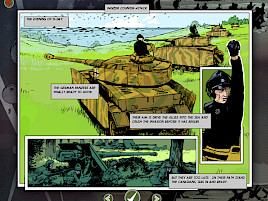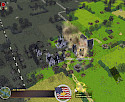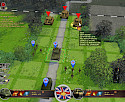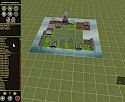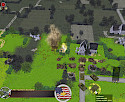Battle Academy Review
BBC Battle Academy is a turn-based wolf in sheep's clothing (and that's my Biblical reference for the year). Look at the graphics. Caricatured. Cartoonish. One might even say a dreaded word that will make grognards everywhere flinch: cute. Look, one of the little tanks is shooting at another tank! How adorable!
And yet, behind this disarming facade, there lies a savage tactical model. Playing out over square grid maps, Battle Academy offers three single-player campaigns of World War II; the Western Desert, Normandy, and the Battle of the Bulge, playing as the Allies throughout. All three are unlocked after completing the brief tutorial, and each campaign is a step up in difficulty. As you progress, you're trusted with force selection and a wider range of units. Although most of your force for each battle is set, you're given enough leeway to tailor your approach, choosing between different types of armour, infantry, transports, and guns. Which you need to do, because the mission variety is better than average. You go from ambushing convoys, to fighting withdrawals, to last-ditch defences, to all-out attacks, and the objectives vary accordingly. The primary objective, the only one you must fulfill to win, is often quite simple; capture x amount of checkpoints, kill y number of enemy units, hold a singe checkpoint for z turns. Each battle also has several secondary objectives, which are optional, but can provide additional entertainment.
Graphically, Battle Academy isn't going to amaze anyone, but it does have a nice style and bright colours, both of which strategy gamers are allergic to. Don't worry, repeated exposure does bring immunity, and soon you won't notice the comic book style, vivid colours, the basic, but charming and energetic animation, or any other visual aspect of the game that dares to stray from the drab norm, and if at any point you do feel ill, just look at the monochrome fog of war effect until you feel better. All the icons are simple and unambiguous. A clever touch are the status notifications that pop up. Move a unit near a hidden enemy, and 'Ambush' will pop up as your unlucky chaps get shot up. Suppression, retreat, rout and so on are given the same treatment, making a technical aspect of your units an attractive visual.
Battle Academy's audio, despite an obviously tight budget, is actually rather good. Although the Allied voices are not tailored to the nationality of the forces you control, they're still enthusiastically done ("The blood!") and varied enough to avoid becoming tiresome. The sound effects are average with some good bits, the shriek and blast of artillery, and the hard metallic clang of shells deflecting off armour being two highlights that are always viscerally enjoyable. The music is somehow warlike, cheery, and damnably catchy, and quite frankly I can do without wandering around for the rest of the day humming and whistling snatches of it. Even though there isn't a lot of variety, it doesn't get irritating, which is a miracle or good composing, both equally rare in game music.
Battle Academy plays quickly, easily, and has tactical depth. The controls are simple, mostly left click/right click, with the arrow keys controlling camera rotation and zoom. The interface is minimal, and like the rest of the game, designed with simplicity and economy of effort in mind. Loading screens are common but brief, although marred by compulsory 'tips' developers feel they have to include, which aren't tips at all but rather obvious things about the game you will know after having played it for half an hour. You can save at any point in battle, and it's very quick to do.
Units have three different ratings, armour-piercing attack, high explosive attack, and armour. Although there is a difference between vehicle front/side/rear armour, this is not displayed, and an overall rating is all you get. Movement is controlled by a limited amount of APs, and each unit has two attacks per turn. Interdependency is assured by a mix of strengths and weaknesses, as tanks cannot see into buildings or woods, infantry are fleshy bags of fluid, and guns rely upon vulnerable transports to move them. Infantry are represented by five-men units for paratroopers, engineers and riflemen, or two-men units for support weapons like mortars, bazookas and machine guns. Combined arms is a complex interplay of roles, and Slitherine have nailed the core of it in Battle Academy. Any one element of your force, isolated from the rest, is of limited use and of course, any enemy units deprived of support are just as vulnerable.
There's a basic experience system, with units gaining promotions for destroying enemy units, and their resulting rank indicated by the number and colour of chevrons over the unit. Units that gain rank receive extra morale and attacks, and units that attain Elite rank end up with new abilities. Just using the units is enjoyable, because controlling them feels ergonomic. Indirect fire weapons like howitzers and mortars are just (im)precise enough to be an amusing gamble, but then so is running your infantry across that stretch of open ground, or sending your tank around that corner, or setting up your machine gun in that isolated house.
You are often given off-map resources, which is how the game handles strafing runs and artillery. Other options include a medic to heal casualties, a drill sergeant to upgrade units, and various air strikes. Once used, you have to wait several turns before they become available again, in some scenarios the AI has them too. It's actually possible to counter strafing runs by enemy aircraft with the use of AA vehicles.
Battle Academy includes something a lot of games ignore outright, yet is a very important factor in combat: suppressive fire. This game could school a lot of others in the application of firepower. Shots that don't kill or injure a unit can still have an effect, denting the unit's morale. When this drops below 50, the unit is suppressed, and cannot attack. This is a great way to silence units until you can assault them (fortified machine gun positions) or take on units that you have great difficulty killing (guten tag King Tiger). Once you're banging shells off their armour like they're the Vomit Gong at Bulimia Camp, even if those shells stand next to no chance of killing the unit in question, they won't stand and fight. One nitpick I have with retreating vehicles is that they don't have a reverse gear. When they flee, they often turn and expose their thinnest armour, at the rear, when really even a Panzer driver cacking his lederhosen is going to chuck it in reverse. This isn't an issue with trucks and lightly armoured vehicles which are easy to kill because of their poor overall armour, but it seems like a slightly cheap way to defang formidable tanks like the Panther and Churchill.
One of the reasons why you need a lot of suppressive fire is that the opportunity fire is absolutely murderous. Although it waxes and wanes, working on some unholy alliance of APs remaining, attacks remaining, facing, and proximity, it's never less than a dire threat, and quite often a nasty surprise from an unexpected angle. There hasn't been reaction fire this bad since the days of X-Com, but of course it works to your advantage as well when the enemy advances and runs a gauntlet of bullets and shells.
Slitherine have walked a fine line while making Battle Academy, charting the borders of Fun, Depth, and Tedium. They've attempted to maximise the first, and include as much of the second as possible without including any of the last. Deploying your units is a simple drag and drop process, you never spend longer setting up than playing the battle, the battlefields offer plenty of room for manoeuvre but are actually quite small, keeping the action focused, and overall the game is simply fun to play. There's obviously plenty of tactical knowledge, but more importantly, good game design, behind it. As an example, instead of designing a complicated terrain system to enable players to use hull-down/reverse slope tactics, there's simply a rule that any unit on a hill won't be spotted until it fires. This still offers a considerable advantage to those occupying the high ground, without a fiddly terrain system, not to mention the terrors of a complicated line-of-sight process.
It's an information-rich game, with the tool tip informing you about your fire effectiveness, chance to hit, chance to penetrate, chance to kill, and the cover rating for the terrain of any tile. One particular aspect I disagree with is that you know too much about enemy units. Attack power, armour, number of remaining attacks, morale, what the unit is before it ever comes into view...most, if not all of this should be hidden from the player. There's also one outright fault, which is that when a unit is spotted, it remains in sight for the remainder of the turn, even if it moves out of sight of your units.
Let's not pretend that AI, so far, can rival a (competent) human, but the silicon mind here certainly isn't bad. It's reassuring to see AI units laying down plenty of suppressive fire after a surprise attack, hitting likely firing points just as a human player does when ambushed. The AI certainly isn't shy, and you definitely know when you're being attacked. I think the scripting, especially for certain missions, does let the side down (quite literally, like when each attack wave is announced in a certain defensive scenario) and certainly limits the replayability of the single-player game. In addition to the three campaigns, there are two special operations. These are survival scenarios, where you set up an all-round defence and hold out for a limited number of turns. While this area of the game is obviously limited at the moment, it's safe to say the developer has plans for the future.
Then there's the multiplayer mode. The first nine maps are basic deathmatches, which have a fairly basic fault; there is no other objective other than hitting the other player so hard they see the curvature of the Earth, which encourages conservative, defensive play, as there's no reason to attack and risk losses which will reduce your chances of winning. So, multiplayer appeal: limited? No, because in the 1.3.6 update, Slitherine included four maps that are actual missions, with proper objectives to hold and capture and stuff, and they have plans to release updates, which will include new maps, on a bi-weekly basis. The play-by-email-system is simple, there's a notifier out there so you have no excuse for missing a turn, and there's an active pool of players. You can't invite someone to a game by email, which is a bit of a shame, but a little competitive encouragement can be found via the rankings. The variety of players and maps means it's going to be a while before you exhaust the possibilities, and that's before you get to...
The editor, being the same used by Slitherine, is no half-hearted effort. Scenarios can be designed for single or multiplayer, so those feeling the lack of a German or Italian campaign can go about creating one. Placement of buildings, terrain, and units is easy, but to complicate matters, you can create mission scripts, assign units to different formations, select points for the AI to follow, and the level of aggression. Slitherine have encouraged use of the editor from the start, with a scenario design forum on their site, and if that isn't enough, a modder's forum for those who can't stop at merely creating scenarios.
There are a few things wrong with Battle Academy, but most of them are minor issues. Damage to the battlefield is purely cosmetic, shooting down aircraft doesn't do anything except foil the current strafing run, the status notifications are nice but technically redundant, the multiplayer results screen doesn't say whether the games were wins or losses, there's no in-game system for browsing or downloading created scenarios, it's World War II again, a dead horse so flogged that there are only bones left, there are reveals of enemy forces that should be hidden by fog of war, the game as a whole is a bit too easy... and I could go on listing any number of small, irritating little annoyances, but nonetheless Battle Academy is a good game. Every campaign entertains, the last one offers a challenge, it's fun and quick to play, Slitherine's updates have punched the lifespan worries right in the face, it's very stable with few minor bugs, you can create and play battles as complex as you want, mod the game easily, play as few or as many multiplayer battles as you like at a wide range of times, and experience a minimum of boredom and frustration.
Back to school with you.


